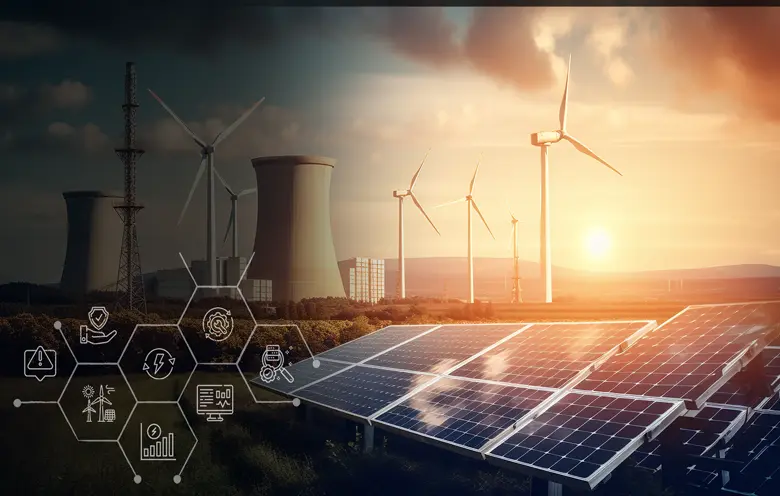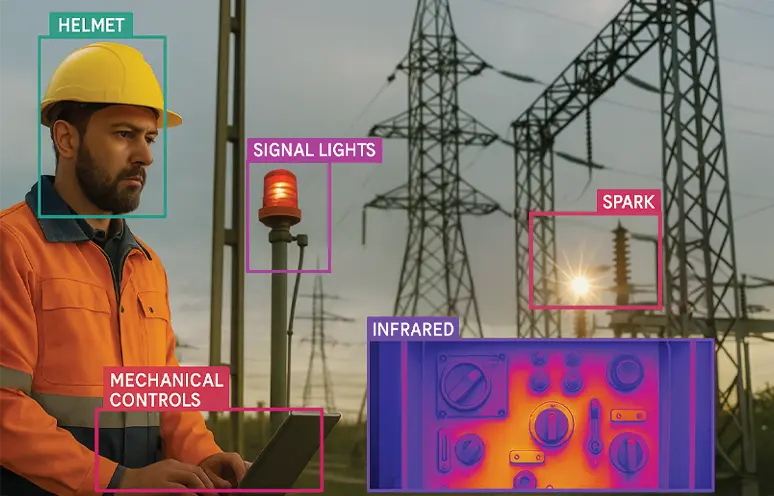Are you tired of grappling with high energy costs and inefficient consumption in your organization? Let’s discover how computer vision technology can help you to reshape the energy industry and transform energy management practices to unlock substantial savings.
Did you know the hidden costs of energy waste?
A huge increase in energy investment is essential to reduce the risks of future price spikes and volatility, and to get on track for net zero emissions by 2050. – IEA
Commercial Energy Waste:
Commercial buildings, including offices, retail spaces, and hospitality establishments, also contribute to the alarming trend, wasting approximately 30% of the energy they consume. This translates into a massive financial loss and an enormous, missed opportunity for savings. (Source: U.S. Environmental Protection Agency – ENERGY STAR)
Industrial Energy Waste:
Manufacturing facilities are responsible for spending $200 billion every year to power facilities and waste nearly 30 percent of that energy. (Constellation Energy Corporation)
Every minute, day and second, an astonishing amount of energy is wasted in an unnecessary manner. This waste is attributed to factors such as inefficient equipment, operational inefficiencies and a lack of visibility into energy consumption patterns.
There are many computer vision services available from different vendors, such as AWS, Azure, and GCP. It’s important to choose the right one for your needs based on its features and capabilities.
In this comprehensive blog, we will unlock the game-changing capabilities of computer vision in the energy sector. You will also learn about computer vision applications for energy industry, from optimizing efficiency to revolutionizing renewable energy sources.
How does computer vision work for energy management?
You can tackle energy waste head-on with computer vision. By leveraging the capabilities of artificial intelligence (AI) and machine learning (ML), computer vision systems can analyze real-time visual data from strategically placed sensors and cameras throughout your facility. This technology enables the system identify energy usage patterns, detect anomalies and provide actionable insights for optimizing energy consumption. So, you must stay ahead of the curve with the latest computer vision trends, enhancing your energy management practices with cutting-edge technologies and innovations.
Some benefits of using computer vision for energy optimization
| Benefits | Description |
| Real-time monitoring |
|
| Precise analytics |
|
| Enhanced automation |
|
| Anomaly detection |
|
| Energy savings |
|
| Proactive sustainability |
|
| Predictive maintenance |
|
| Compliance and reporting |
|
| Remote access and control |
|
| Competitive advantage |
|
Some use cases for computer vision in the energy industry
Let’s explore the practical applications of computer vision in energy management, such as:
Real-time monitoring and analytics:
Real-time monitoring and analytics are at the core of computer vision for energy management. Equipped with smart sensors and thermal imaging cameras, computer vision systems monitor energy-consuming processes in real-time.
They detect anomalies, identify potential energy waste and provide you with actionable insights. Say goodbye to reactive approaches and hello to proactive decision-making. With computer vision, you can swiftly address issues, reduce energy consumption and optimize resource allocation like never before.
Example: A manufacturing plant can use thermal imaging cameras to monitor energy-intensive processes. The company can also identify areas where energy is being wasted, such as inefficient machinery or improper settings.
Predictive maintenance and energy forecasting:
Computer vision enables predictive maintenance and energy forecasting, saving you from unnecessary downtime and inflated costs. By analyzing historical data and identifying patterns, computer vision systems accurately forecast energy usage and equipment failures.
No more outdated maintenance approaches. With computer vision, you can anticipate maintenance needs, optimize equipment performance and extend critical assets’ lifespan. It’s like having a crystal ball for your energy infrastructure.
Example: A wind farm can leverage computer vision to analyze data from turbines and predict maintenance requirements, preventing costly failures and maximizing energy generation.
Energy efficiency insights:
Energy efficiency is a top priority for energy managers, and computer vision is here to take it to the next level. By analyzing visual data collected from smart meters and sensors, energy management systems equipped with computer vision can:
- Identify energy-intensive areas
- Peak usage periods
- Untapped opportunities for optimization
Armed with this valuable information, you can make informed decisions and implement energy-saving strategies that result in significant cost reductions and environmental benefits. It’s a win-win for your bottom line and the planet.
Example: An office building can utilize computer vision to analyze occupancy patterns and adjust lighting and HVAC systems. Accordingly, you can reduce energy consumption during low occupancy periods.
Occupancy and lighting optimization:
Optimizing lighting and HVAC systems is easy with computer vision. By combining intelligent algorithms with visual data, computer vision accurately detects occupancy levels and adjusts lighting and temperature accordingly.
No more wasting energy in empty rooms or overworking HVAC systems. With computer vision, you can achieve the ideal balance between comfort and energy efficiency. This leads to substantial energy savings and happier occupants.
Renewable energy integration:
As you embrace renewable energy sources like solar panels and wind turbines, computer vision becomes your trusted ally.
It optimizes the alignment and performance of these systems by tracking the sun’s movement, predicting weather patterns and adjusting renewable energy systems in real-time. This means maximum energy capture and maximum efficiency, bringing you one step closer to a sustainable energy future.
Example: A solar farm can employ computer vision to track the sun’s position and adjust the tilt and orientation of solar panels throughout the day, optimizing energy generation.
Asset monitoring and maintenance:
Computer vision technology is used to monitor and maintain critical assets in the energy industry. For example, drones equipped with computer vision algorithms can inspect power lines and detect signs of wear and tear or damage, such as loose fittings or corrosion. This proactive approach to asset monitoring prevents failures and reduces downtime, ultimately saving costs and ensuring an uninterrupted power supply.
Energy consumption optimization:
Computer vision can optimize energy consumption within buildings by analyzing occupancy patterns and environmental conditions. By utilizing cameras and machine learning algorithms, energy management systems can adjust lighting, heating and cooling based on real-time occupancy and lighting conditions. This results in significant energy savings while maintaining optimal comfort levels for occupants.
Example: A commercial building can leverage computer vision to adjust lighting and HVAC systems based on real-time occupancy data, ensuring energy is used efficiently in each area of the building.
Security and safety enhancements:
Video surveillance systems equipped with facial recognition capabilities can identify authorized personnel and detect unauthorized access to restricted areas.
Additionally, computer vision can detect potential safety hazards, such as spills or fires, and trigger immediate alerts, enabling quick response and preventing accidents.
Example: An oil refinery can employ computer vision-enabled surveillance cameras to identify and alert security personnel of any unauthorized access to restricted areas, ensuring the safety and security of the facility.
Fault detection and predictive maintenance:
Computer vision systems can analyze data from sensors and cameras to detect faults and anomalies in energy infrastructure. By capturing real-time images and videos, computer vision algorithms can identify equipment malfunctions, leaks, or abnormal behavior. This enables energy companies to take proactive measures and schedule maintenance before failures occur, improving operational efficiency and minimizing downtime.
Example: A natural gas pipeline company can utilize computer vision to analyze visual data from pipeline monitoring systems, detecting leaks or anomalies and trigger immediate maintenance actions to prevent accidents or disruptions. This proactive approach of Computer vision for leak detection not only ensures the safety and integrity of the pipeline but also minimizes environmental risks and operational downtime.
Grid monitoring and optimization:
Computer vision monitors power grids and identifies potential issues or vulnerabilities. By analyzing data from sensors, drones and satellite imagery, computer vision algorithms can detect vegetation encroachment on power lines. They can also identify areas with high transmission losses or pinpoint equipment hotspots. This information helps energy companies optimize grid operations, improve efficiency and reduce system losses.
Example: An electric power company can employ computer vision to monitor power lines and quickly identify areas where vegetation is encroaching, allowing them to take proactive measures and prevent potential power outages caused by tree contact.
Renewable energy resource management:
Computer vision is instrumental in managing renewable energy resources effectively. For example, solar farms can utilize computer vision systems to track the sun’s movement and adjust the solar panels’ tilt and orientation accordingly.
This ensures maximum energy capture throughout the day, optimizing the solar installation’s efficiency. Computer vision can also monitor wind farms, identify turbine performance issues and predict maintenance requirements.
Example: A wind energy company can utilize computer vision to track wind turbine performance, detecting any deviations from normal operation and predicting maintenance requirements to maximize energy production and turbine lifespan.
Environmental monitoring:
Computer vision can aid in environmental monitoring related to energy operations. For instance, cameras equipped with computer vision algorithms can detect and analyze emissions from industrial facilities, ensuring compliance with environmental regulations. By continuously monitoring and analyzing air and water quality, energy companies can mitigate adverse environmental impacts.
Unleashing computer vision’s potential in the energy industry
It is high time to recognize the significance of computer vision vs. traditional energy management methods, as countless large companies have already harnessed the power of energy efficiency and sustainability to propel their success forward.
Implementing computer vision services can significantly improve energy optimization and ROI for businesses. However, it comes with its own set of challenges. Stay tuned for our upcoming blog where we discuss these challenges and customized solutions. Partner with trusted experts like Softweb Solutions for successful implementation of computer vision in energy monitoring, waste reduction and increased ROI.


